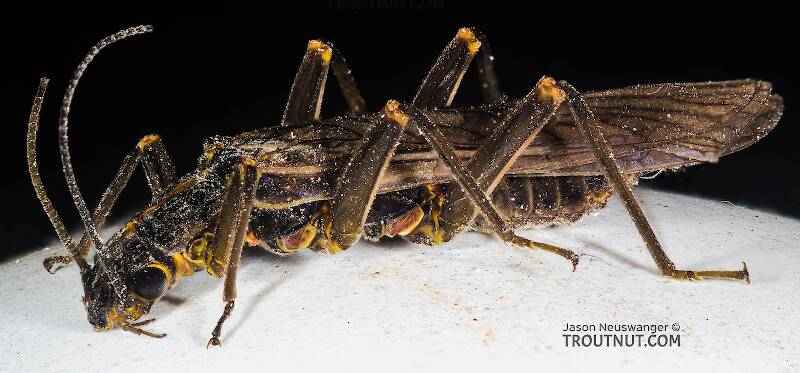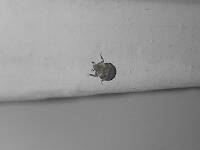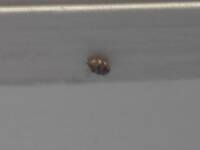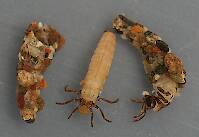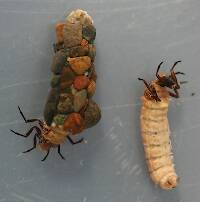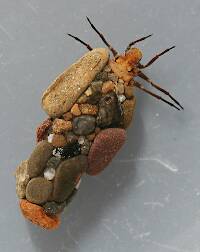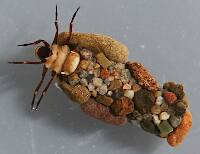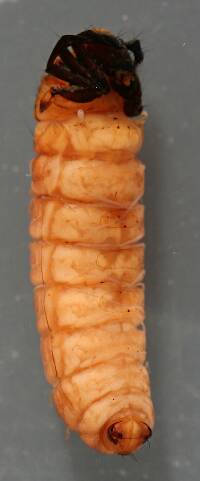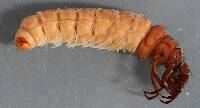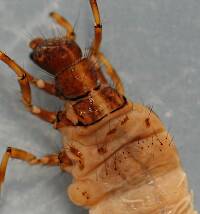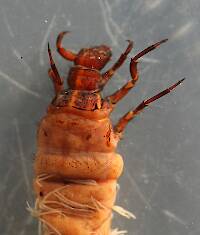
Hex Mayflies
Hexagenia limbata
The famous nocturnal Hex hatch of the Midwest (and a few other lucky locations) stirs to the surface mythically large brown trout that only touch streamers for the rest of the year.
Featured on the forum

Troutnut is a project started in 2003 by salmonid ecologist Jason "Troutnut" Neuswanger to help anglers and
fly tyers unabashedly embrace the entomological side of the sport. Learn more about Troutnut or
support the project for an enhanced experience here.
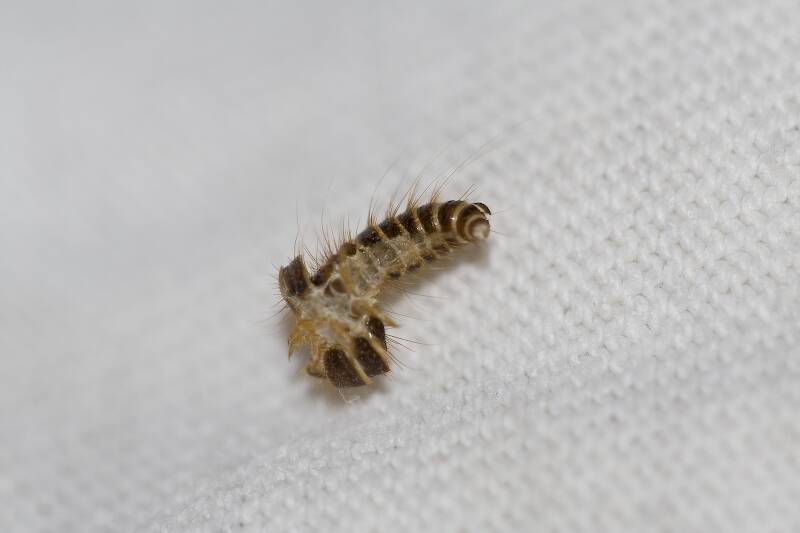
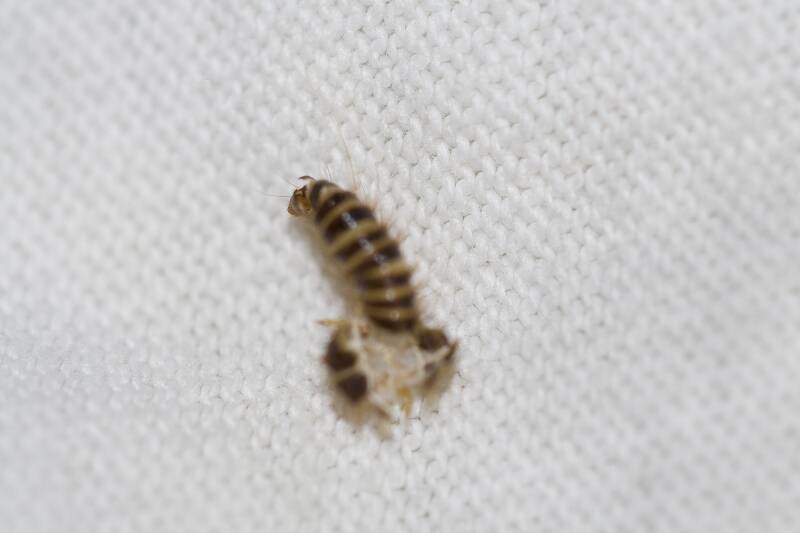
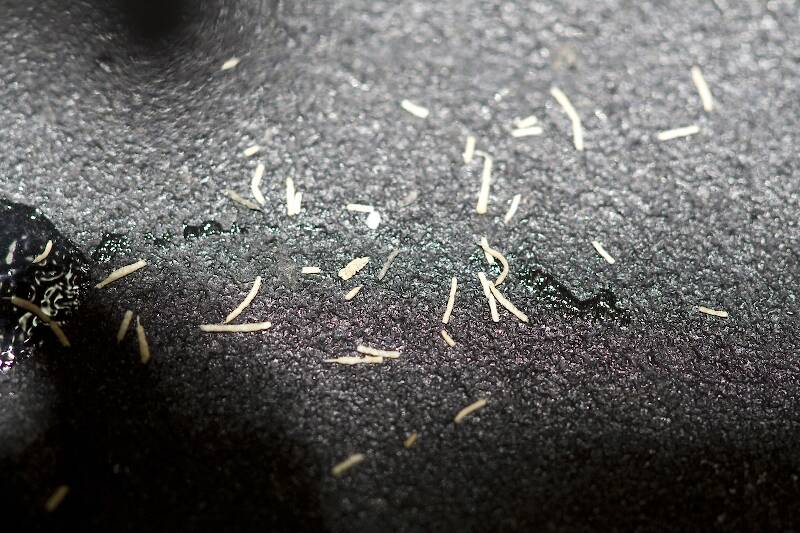
Shawnny3 on Aug 21, 2010August 21st, 2010, 4:08 pm EDT
I opened a bag with some rabbit skins in it for the first time in a while. I noticed a bunch of these cream-colored rods, ranging from 1 to 3 mm long, floating around in there. I wondered if these were insect eggs of some kind and might be the first stages of an infestation. Can anyone help I.D. these things?
Thanks,
Shawn
Thanks,
Shawn
Jewelry-Quality Artistic Salmon Flies, by Shawn Davis
www.davisflydesigns.com
www.davisflydesigns.com
GONZO on Aug 21, 2010August 21st, 2010, 4:34 pm EDT
Hmmm, they look like.....boogers. Sorry I can't be more specific, Shawn, but I draw the line at nose candy. I'd have it looked into. (And you wonder why I tie with synthetics?) :)
Gutcutter on Aug 21, 2010August 21st, 2010, 4:59 pm EDT
boogers?
thats the best you can come up with gonzo?
come on, the real medical term is "dried snot"
shawn - was it a hunter harvest and home preserved skin or something packaged by hareline or another reputable brand?
does anybody besides me still use mothballs with their skins?
gut
thats the best you can come up with gonzo?
come on, the real medical term is "dried snot"
shawn - was it a hunter harvest and home preserved skin or something packaged by hareline or another reputable brand?
does anybody besides me still use mothballs with their skins?
gut
All men who fish may in turn be divided into two parts: those who fish for trout and those who don't. Trout fishermen are a race apart: they are a dedicated crew- indolent, improvident, and quietly mad.
-Robert Traver, Trout Madness
-Robert Traver, Trout Madness
Shawnny3 on Aug 22, 2010August 22nd, 2010, 1:41 am EDT
Thanks for nothing, Gonzo - a supremely unhelpful and adolescent response. And curse your synthetics - may they rot slowly over the next million years.
Tony, good question. They were hunter-harvested and home-dried. I usually rub Borax into the skins as they're drying, but I may have missed this batch - I'm not seeing white powder on the skins.
I took the bag outside and took a closer look at it. I found what appeared to be the shell from a molted millipede in it. Whether the "eggs" or millipede are related finds or not, I think I'm going to be safe, toss the bag, and carefully inspect the rest of the bags in that drawer.
Interesting you ask about mothballs, Tony. I've never liked the smell of them on my materials (and, consequently, my hands) when I'm tying. Also, the naphthalene forms a slightly oily/gritty residue on my materials which adversely affects how they perform at the vise (this is particularly true of feathers used for marrying). I do, however, like the smell of cedar, and I've been thinking for awhile that I should put cedar chips into my tying supplies, but I just haven't gotten around to it. This little incident may be just the motivation I need. I'm very fortunate that the affected skins were some free rabbit skins and not some really expensive feathers. Time to get more careful.
-Shawn
Tony, good question. They were hunter-harvested and home-dried. I usually rub Borax into the skins as they're drying, but I may have missed this batch - I'm not seeing white powder on the skins.
I took the bag outside and took a closer look at it. I found what appeared to be the shell from a molted millipede in it. Whether the "eggs" or millipede are related finds or not, I think I'm going to be safe, toss the bag, and carefully inspect the rest of the bags in that drawer.
Interesting you ask about mothballs, Tony. I've never liked the smell of them on my materials (and, consequently, my hands) when I'm tying. Also, the naphthalene forms a slightly oily/gritty residue on my materials which adversely affects how they perform at the vise (this is particularly true of feathers used for marrying). I do, however, like the smell of cedar, and I've been thinking for awhile that I should put cedar chips into my tying supplies, but I just haven't gotten around to it. This little incident may be just the motivation I need. I'm very fortunate that the affected skins were some free rabbit skins and not some really expensive feathers. Time to get more careful.
-Shawn
Jewelry-Quality Artistic Salmon Flies, by Shawn Davis
www.davisflydesigns.com
www.davisflydesigns.com
Lastchance on Aug 22, 2010August 22nd, 2010, 2:56 am EDT
People in the know use cedar chips or cedar balls. I've used them for years with no problem. Mothballs and their fumes are toxic. I once used them in my apartment and everything I owned smelled like mothballs, except the mothballs, that smelled like, well you know, mine. I have stored tanned hides and those I've tanned my self. No problems.
Oldredbarn on Aug 22, 2010August 22nd, 2010, 4:59 am EDT
Hey it's Sunday morning and I'm trying not to listen to the talking heads this morning on the tube...I can't figure out why I even turn the thing on!
My two cents...I store my natural materials in an old cedar hope chest and I sit a box of moth balls in the corner of it...Shawn if you were running unprotected you were asking for trouble...It's not unlike protecting your computer or wearing a condom from time-to-time :). It makes good sense.
I think you are doing the right thing by removing the doubtful packet. When you use homemade stuff it should remain segragated from your other stuff for some time and inspected before it joins the other stuff. The nice thing is that the way we store this stuff usually in plastic ziplock baggies can help limit the extent of the loss.
I think that the bigger Browns on the Au Sable are actually addicted to the aroma of moth balls, sort of like crack-heads, and its attracting quality is better than Berkleys Power-Bait...:)
Spence
My two cents...I store my natural materials in an old cedar hope chest and I sit a box of moth balls in the corner of it...Shawn if you were running unprotected you were asking for trouble...It's not unlike protecting your computer or wearing a condom from time-to-time :). It makes good sense.
I think you are doing the right thing by removing the doubtful packet. When you use homemade stuff it should remain segragated from your other stuff for some time and inspected before it joins the other stuff. The nice thing is that the way we store this stuff usually in plastic ziplock baggies can help limit the extent of the loss.
I think that the bigger Browns on the Au Sable are actually addicted to the aroma of moth balls, sort of like crack-heads, and its attracting quality is better than Berkleys Power-Bait...:)
Spence
"Even when my best efforts fail it's a satisfying challenge, and that, after all, is the essence of fly fishing." -Chauncy Lively
"Envy not the man who lives beside the river, but the man the river flows through." Joseph T Heywood
"Envy not the man who lives beside the river, but the man the river flows through." Joseph T Heywood
Shawnny3 on Aug 22, 2010August 22nd, 2010, 5:52 am EDT
Thanks, guys. Cedar chips are now in every bag and drawer I have. When I get materials from hunters, farmers, or other tiers (sometimes even from materials suppliers if I feel the material is not clean enough), the first thing I do is wash them well in a solution of Woolite. After a good soaking (at least overnight), I rinse and dry them either pinned on cardboard (skins) or on glass (loose feathers). The cardboard helps to draw out oils from the skins. When they're nearly dry, I rub Borax into the skins. Then I put the materials into a freezer for several months (I'm told this disinfects them, but I'm somewhat skeptical of that). After that, they join my other materials. From now on, cedar chips will accompany every bag.
-Shawn
-Shawn
Jewelry-Quality Artistic Salmon Flies, by Shawn Davis
www.davisflydesigns.com
www.davisflydesigns.com
Oldredbarn on Aug 22, 2010August 22nd, 2010, 7:25 am EDT
That's a good boy Shawn! Safe sex may be boring and unfulfilling at times, but an ounce of prevention is worth a pound of cure...
If you are like the rest of us here, there are some expensive necks/saddles in your box, and if the little critters get to them it will be a sad, sad, day.
Take Care!
Spence
If you are like the rest of us here, there are some expensive necks/saddles in your box, and if the little critters get to them it will be a sad, sad, day.
Take Care!
Spence
"Even when my best efforts fail it's a satisfying challenge, and that, after all, is the essence of fly fishing." -Chauncy Lively
"Envy not the man who lives beside the river, but the man the river flows through." Joseph T Heywood
"Envy not the man who lives beside the river, but the man the river flows through." Joseph T Heywood
Shawnny3 on Aug 22, 2010August 22nd, 2010, 12:50 pm EDT
Gonzo PMed me a really nice bit of homework he did on this, and it got me thinking that I should post pics of the molted skin I found. In hindsight, what I thought was a millipede with lots of legs is actually something else with lots of hairy projections. Gotta love the macro lens, even if I really don't know how to use it.
-Shawn
-Shawn
Jewelry-Quality Artistic Salmon Flies, by Shawn Davis
www.davisflydesigns.com
www.davisflydesigns.com
GONZO on Aug 22, 2010August 22nd, 2010, 1:30 pm EDT
Shawn, the new photos do look a lot like the shed skin of a dermestid beetle larva. It seems these bunny cloaks may have had multiple issues.
Per Shawn's suggestion, I'll copy the pertinent parts of my PM. But first I want to share the unedited version of the line he used in response to my "booger" post. He thought it might be over the top, but I like it: "And curse your synthetics - may they rot slowly over the next million years, returning to the crude oil from which they came." :)
(Quoted information is from a University of Florida website.)
Per Shawn's suggestion, I'll copy the pertinent parts of my PM. But first I want to share the unedited version of the line he used in response to my "booger" post. He thought it might be over the top, but I like it: "And curse your synthetics - may they rot slowly over the next million years, returning to the crude oil from which they came." :)
The usual suspects with stored skins are dermestid beetles, but there was nothing in the photos that I could associate with them. Although there appeared to be some eggs in the center of the photo, I suspected that the long "rods" were the (sometimes shriveled and broken) remains of some type of larvae. The slight suggestion of segmentation on some of them and the little projections on the tapered ends made this seem likely.
My next thought was that these might be tineid moth larvae--which are pests of wool, fur, and hair--but they didn't look right. Tineid larvae usually have brown heads, can be up to 1/2" long, and are associated with silken webs and cases (which you did not mention).
As it turned out, the culprit that I now suspect is not one I knew to be a pest of fly-tying materials. I believe that the bunny boogers are probably maggots--the larvae of Piophila casei (Diptera, or true flies), also known as "cheese skippers." I won't go into all of the fascinating and disgusting details I learned about this species, but the little projections on the tapered ends of the larvae (actually the heads) are basically "meat rakes." The little cluster in the center of the photo could fit a description of the eggs: "The eggs of the cheese skipper are 0.63-0.74 mm long (Lui and Greenberg 1989) and 0.18-0.2 mm wide....The chorion (shell) of each egg is oval/cylindrical and a smooth, pearly white color."
The casei larvae "appear white or yellowish-white to the unaided eye." Here is a photo of an intact--probably half-grown--larva (notice the hooks on the tapered head):
http://entnemdept.ifas.ufl.edu/creatures/urban/flies/cheese_skipper03.htm
And here is some info about their feeding habits:
Piophila casei usually feed on overripe (three or more months old) and moldy cheese, and slightly salted or putrid-smelling meats, such as ham, bacon, and beef. Larvae are typically found on high-protein substrates ranging from salted beef to smoked fish and animal carcasses (Smith and Whitman 2000)....Forensic entomologists have used the presence of P. casei larvae as a tool to assist in the estimation of time of death for human remains. Though they can appear on remains less than two months old in geographic locations such as Florida, the flies sometimes do not appear on an exposed corpse until three to six months postmortem (after death), usually after the body has completed the "active decay" decomposition stage and is beginning to dry (Nanzi et al 2008). Entomologists utilize knowledge of the current instar of collected larvae, coupled with measurements of weather and temperature conditions, to provide an estimation of the postmortem interval (Benecke 1998).
They seem to be a fairly minor and somewhat uncommon pest of improperly processed hides (especially when compared to dermestid beetles) and have a rather short life cycle. However, the larger concern would be that the adult flies could find their way to your food. Accidental ingestion of the larvae is a cause of enteric myiasis and the flies may be vectors of other diseases.
BTW, although commonly used, cedar is only slightly effective in deterring tineid mothes. Camphor or lavender oil may be more effective and easier to refresh. Cedar will not deter dermestid beetles and even the potent PDB mothballs are not very effective (and melt plastics, though I suppose that's more of a concern for me). I would suggest storing all "home-processed" skins in separate sealed bags, and keeping them away from other materials. In the case of an infestation, you might want to try dry-ice fumigation.
(Quoted information is from a University of Florida website.)
Jmd123 on Aug 22, 2010August 22nd, 2010, 5:39 pm EDT
Beetle larvae, for sure. Dermestid beetles LOVE old fur. Don't know if trout would go for them, but who knows, in case you tie up a few Gold Ribbed Hare's Ears and one of these hitches a ride...but now, that would be cheating, wouldn't it? LIVE BAIT???
;oD
Jonathon
;oD
Jonathon
No matter how big the one you just caught is, there's always a bigger one out there somewhere...
Jmd123 on Aug 22, 2010August 22nd, 2010, 5:42 pm EDT
P.S. Somehow I have managed to avoid any infestations of my fly tying materials, even though I have had some of them for 20 years...Must be how tightly packed I have them most of the time in tackle boxes, but, as an entomologist, I know better...
JMD
JMD
No matter how big the one you just caught is, there's always a bigger one out there somewhere...
Shawnny3 on Aug 23, 2010August 23rd, 2010, 8:38 am EDT
Thanks for the replies, gentlemen. Very instructive.
A word to the wise: One has to be careful when uttering curses about synthetics - wishing a slow decay is the safest bet. Sadly, I just tied up a really nice looking caddis pupa yesterday with a blend of Scintilla and Antron dubbing, plastic overback, melted mono eyes, and nylon thread. Estimated half-life: 432,000 years. I'm hoping to catch a few fish with it by then. At least there weren't any beetles in any of those bags.
-Shawn
A word to the wise: One has to be careful when uttering curses about synthetics - wishing a slow decay is the safest bet. Sadly, I just tied up a really nice looking caddis pupa yesterday with a blend of Scintilla and Antron dubbing, plastic overback, melted mono eyes, and nylon thread. Estimated half-life: 432,000 years. I'm hoping to catch a few fish with it by then. At least there weren't any beetles in any of those bags.
-Shawn
Jewelry-Quality Artistic Salmon Flies, by Shawn Davis
www.davisflydesigns.com
www.davisflydesigns.com
Oldredbarn on Aug 23, 2010August 23rd, 2010, 9:13 am EDT
Shawnny! Say it isn't so...Mister G has actually pulled you to the "Dark Side"...(?!) A few funky invasive critters in your fly-tying stash and you run for the hills? Oh well I guess there's no point swiming against the flood, upstream, only to find a dam blocking your way...
Actually I have some stuff I got from Madison River Fishing Co years ago, I can't remember the name of it here in the office, that blends nicely with natural furs to add a little flash to caddis bodies...I remember calling them years later and asking for some more and they told me they had stopped offering it...When I asked them why they said, "Spence, only you and that friend of yours in Michigan were the only ones that ever bought any!" How's that for some secret stash?!
I should send you a PM so just you and I will know what's what and we can drive Mister G crazy because you and I will have the secret sauce and he won't!;) You and I will call our blends "Caddis-Crack" or "Caddis Candy"...Or something like that.
Spence
with a blend of Scintilla and Antron dubbing
Actually I have some stuff I got from Madison River Fishing Co years ago, I can't remember the name of it here in the office, that blends nicely with natural furs to add a little flash to caddis bodies...I remember calling them years later and asking for some more and they told me they had stopped offering it...When I asked them why they said, "Spence, only you and that friend of yours in Michigan were the only ones that ever bought any!" How's that for some secret stash?!
I should send you a PM so just you and I will know what's what and we can drive Mister G crazy because you and I will have the secret sauce and he won't!;) You and I will call our blends "Caddis-Crack" or "Caddis Candy"...Or something like that.
Spence
"Even when my best efforts fail it's a satisfying challenge, and that, after all, is the essence of fly fishing." -Chauncy Lively
"Envy not the man who lives beside the river, but the man the river flows through." Joseph T Heywood
"Envy not the man who lives beside the river, but the man the river flows through." Joseph T Heywood
Shawnny3 on Aug 23, 2010August 23rd, 2010, 9:58 am EDT
I'm not proud of it, Spence. As I said, a truly sad day. Then again, there aren't a lot of rabbits running around with fluorescent green pelts. Not that that excuses the offense.
-Shawn
-Shawn
Jewelry-Quality Artistic Salmon Flies, by Shawn Davis
www.davisflydesigns.com
www.davisflydesigns.com
Gutcutter on Aug 24, 2010August 24th, 2010, 10:47 am EDT
there aren't a lot of rabbits running around with fluorescent green pelts
shawnny
you live in central penna now. haven't you ever been to a bunny hunt on three mile island?
shawnny
you live in central penna now. haven't you ever been to a bunny hunt on three mile island?
All men who fish may in turn be divided into two parts: those who fish for trout and those who don't. Trout fishermen are a race apart: they are a dedicated crew- indolent, improvident, and quietly mad.
-Robert Traver, Trout Madness
-Robert Traver, Trout Madness
Shawnny3 on Aug 24, 2010August 24th, 2010, 11:44 am EDT
Good call, Tony. I'm going to have to get some of my hunter buddies on that right away.
-Shawn
-Shawn
Jewelry-Quality Artistic Salmon Flies, by Shawn Davis
www.davisflydesigns.com
www.davisflydesigns.com
Zugbuggin on Aug 25, 2010August 25th, 2010, 9:48 am EDT
Several years ago I had something simlar attack a tightly close box of necks, they were store bought but they really got messed up. When I buy natural materials they go in the freezer for a week or 2 then in my storage boxes. Haven't had that problem since
Zug
Zug
Quick Reply
Related Discussions
Topic
Replies
Last Reply
4
Nov 1, 2012
by Entoman
by Entoman


